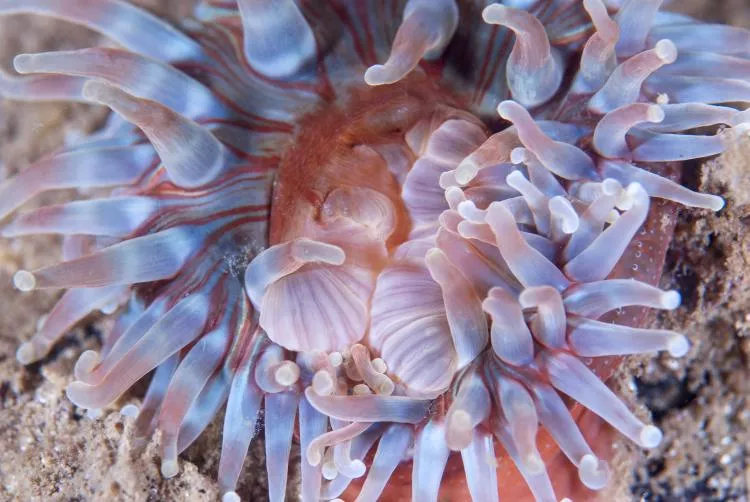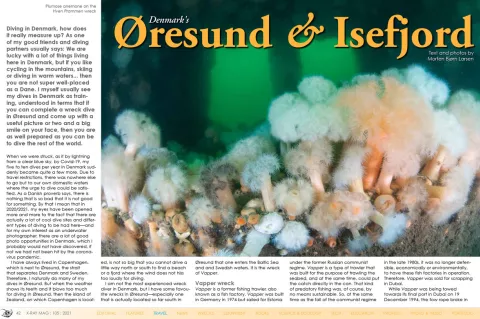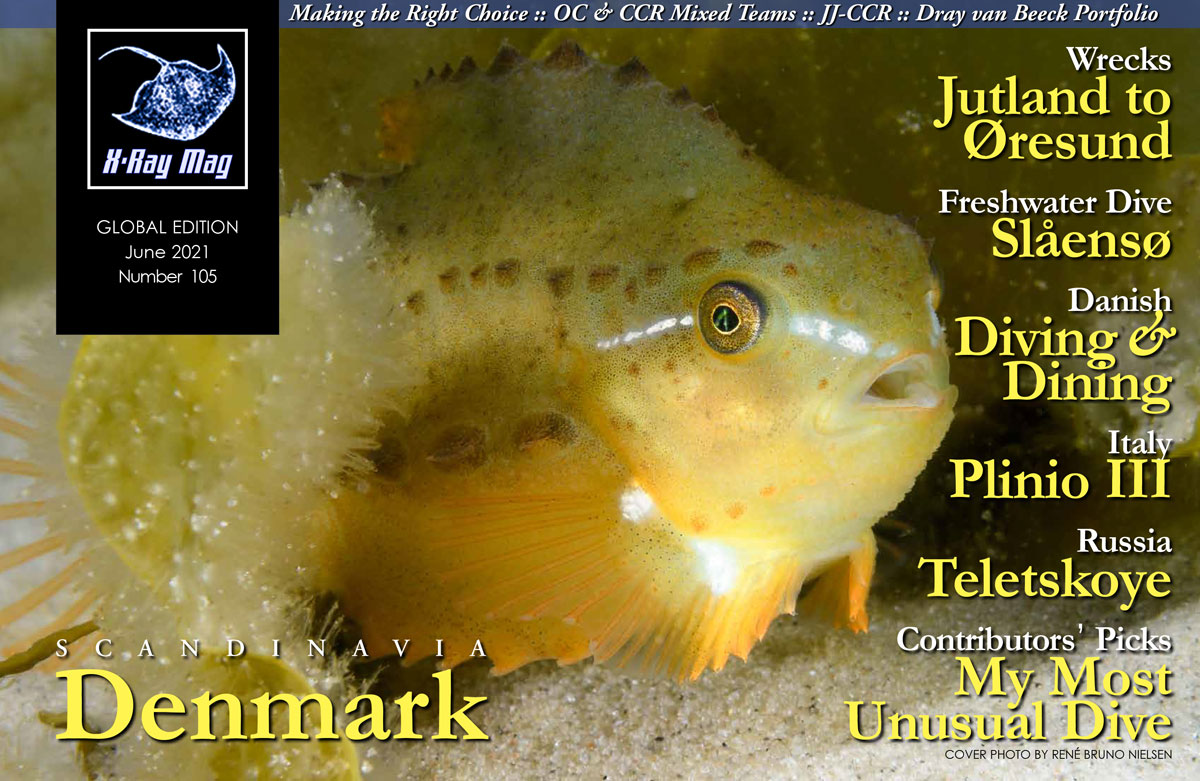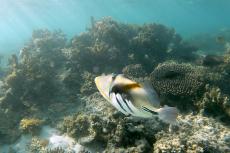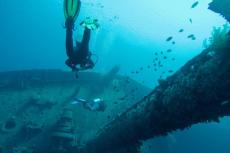Diving in Denmark, how does it really measure up? Since Morten Bjørn Larsen lives in Copenhagen, he talks about his favorite dives in and around the island of Zealand, where the capital city is located. Several wrecks in Øresund and a bridge in Isefjord top the list.
Contributed by
As one of my good friends and diving partners usually says: We are lucky with a lot of things living here in Denmark, but if you like cycling in the mountains, skiing or diving in warm waters... then you are not super well-placed as a Dane. I myself usually see my dives in Denmark as training, understood in terms that if you can complete a wreck dive in Øresund and come up with a useful picture or two and a big smile on your face, then you are as well prepared as you can be to dive the rest of the world.
When we were struck, as if by lightning from a clear blue sky, by Covid-19, my five to ten dives per year in Denmark suddenly became quite a few more. Due to travel restrictions, there was nowhere else to go but to our own domestic waters where the urge to dive could be satisfied. As a Danish proverb says, there is nothing that is so bad that it is not good for something. By that I mean that in 2020/2021, my eyes have been opened more and more to the fact that there are actually a lot of cool dive sites and different types of diving to be had here—and for my own interest as an underwater photographer, there are a lot of good photo opportunities in Denmark, which I probably would not have discovered, if not we had not been hit by the coronavirus pandemic.
I have always lived in Copenhagen, which is next to Øresund, the strait that separates Denmark and Sweden. Therefore, I naturally do many of my dives in Øresund. But when the weather shows its teeth and it blows too much for diving in Øresund, then the island of Zealand, on which Copenhagen is located, is not so big that you cannot drive a little way north or south to find a beach or a fjord where the wind does not hiss too loudly for diving.
I am not the most experienced wreck diver in Denmark, but I have some favourite wrecks in Øresund—especially one that is actually located so far south in Øresund that one enters the Baltic Sea and and Swedish waters. It is the wreck of Vapper.
Vapper wreck
Vapper is a former fishing trawler, also known as a fish factory. Vapper was built in Germany in 1974 but sailed for Estonia under the former Russian communist regime. Vapper is a type of trawler that was built for the purpose of trawling the seabed, and at the same time, could put the catch directly in the can. That kind of predatory fishing was, of course, by no means sustainable. So, at the same time as the fall of the communist regime in the late 1980s, it was no longer defensible, economically or environmentally, to have these fish factories in operation. Therefore, Vapper was sold for scrapping in Dubai.
While Vapper was being towed towards its final port in Dubai on 19 December 1994, the tow rope broke in severe weather. I have heard stories that the Russians had a particular tendency to “lose” their ships on the way during towing—surely after the payment had been dropped... But that might be just a caper story. At any rate, it has at least provided us with a really good wreck to dive.
Diving the wreck
From 1995 to the year 2000, diving was banned on the Vapper wreck, due to the danger of oil spills. In the early years, it was easy to find the wreck as the top of the masts still stuck a few feet above the water. However, the first time I dived the Vapper in 2007, they were removed. But to the top of the bridge, which was only at six meters depth, clear markers had been tied. Vapper is truly a Donald Duck type of wreck, standing upright on the sandy bottom. And with the top at six meters depth and the bottom at 25m, Vapper can be dived by most people with a hankering for a good Danish wreck dive.
It is a large wreck, so I always recommend doing at least two dives on the same day. I once tried to do it in one dive once, when the viz was about one meter, and it was a shame, of course, because then the first-time Vapper divers could not get the right “wow” feeling for the size of the wreck. But apart from that one day of bad visibility, I have mostly experienced fairly good visibility, for Danish waters, to be something like 10 metres. In terms of relatively decent visibility, wind and weather, these were dives we did in September and October.
If you take a tour around the wreck, there is plenty to look at. The chute in the aft deck, where the large nets filled with the day’s catch were once hauled up, is a beautiful sight. If you swim over the edge of the chute and down to the bottom, you will find the screw propeller, which protrudes, free of the sand, at a depth of 24m.
Underwater photography. If you like to take pictures, then the whole area down by the propeller is a good place for subjects. I once spent most of a dive placing a flash behind the propeller, while I, at the same time, from the opposite side of the propeller, tried to take photos of a diver in silhouette against the green water around him. It worked out fairly well, but it is actually a picture I would very much like to go back and try to do better.
Aft deck. In the aft deck, you can find some descent holes that lead down to the fish factory itself. In the fish factory, you will find the equipment that was used to get the catch ready for resale. You must, of course, have a couple of good dive lights with you down there, and be careful not to kick up too much silt. But it is definitely a fun experience to see the old conveyor belts and refrigerators and freezers down in the fish factory.
Wheelhouse. Even if you are not certified for wreck penetration, you can easily get into the wheelhouse and look around. It is not dark in there, both since it is not deeper than about 10 meters and also because the hatches and doors have been removed so that natural light can better penetrate the space. Considering Vapper’s size, there are definitely many other penetration options that I still have yet to try. But it will have to wait until sometime when I can dive Vapper with someone who knows the interior well enough that it is safe to make the trip through the wreck’s interior.
Deck. Up on the deck itself, you will also find big game, the remains of davits and two large funnels, plus many other interesting details. Large parts of the wreck are covered by a layer of mussels, which is very characteristic of the Baltic Sea. If the visibility is good, you should also try descending to kneel on the bottom, looking up towards the bow. It is a beautiful sight to see the wreck towering up against the light.
Hven Prammen
Another one of my absolute favourite wrecks, Hven Prammen, is located in Øresund itself. When you reach its position, the sonar scanner will show quite clearly that it is a barge. A completely square formation appeared on the screen, when our dive boat maneuvered over the Hven Prammen to drop anchor. I thinks it gives you a little extra excitement and desire to descend and explore the wreck when you have just seen a clear outline of the wreck you are about to dive on.
If you have to dive with a large camera, we have learned from experience that when there is current in Øresund, it is clearly best to let others without a camera—or in other words—with free hands, to go first to tie on, and then you descend as the second or third team member. We have, of course, clipped our cameras to a D-ring on our vests, so we will be able to use our hands without losing our lovely hobby toys, in case a situation arises when both hands are needed. But as a starting point, I would rather hold onto my camera gear while descending down an anchor rope in current. The actual process of attaching a line to the right place on a wreck in Øresund, where visibility is not always super, is also just a little more cumbersome with a large camera in tow.
When you start descending to the wreck, it may require a bit of fin work to get down to Hven Prammen without pulling too much on the anchor. Hven Prammen begins at a depth of about 20m, but already at 15m, the current often disappears. It is really nice to be able to relax and enjoy the wreck, which appears before you, at the end of the anchor. At this point, it can be very nice to take a brief pause, still tied to the downline, just to adjust your camera settings and the flash, before you continue diving further.
Navigation. From the sonar image, you can see that if you follow the wreck around its hull, then you simply have to turn when you encounter a 90-degree angle. That way, you will always end up back at the anchor, after the fourth turn. It can be a safe way to navigate, if it is a day when visibility is not as good. But if you hit one of the good viz days in Øresund, you can easily explore the wreck a little more.
If you descend to one corner of the wreck, you will see that it is overgrown sporadically with frilled anemones, while, at the same time, metal surfaces are also visible. It is very similar to a huge box right there in the middle of the sand. If you swim a little farther, around the next corner, some large columns appear. These columns go from the bottom and up to the deck. The columns are very nicely overgrown with anemones in brilliant orange, red and white.
Pillars. At the pillars, it is also possible to dive inside and continue up through something that has probably been a cargo hold. After a good photo op at the pillars, continue a bit farther to find some hatch holes that you can easily enter. The growth on the ceiling here is really beautiful. It is not possible to put a hand anywhere on the ceiling without hitting and damaging a dahlia or plumose anemone.
I do not know much about marine biology, so I do not know out why they thrive so well on that ceiling—inside a wreck where there is never an honest ray of sunshine, and well, there cannot be much current bringing nourishment. But it certainly looks nice when you tilt your dive torch to light up the lushly decorated ceiling. Thereafter, it is easy to dive around the last part, and find the anchor silhouetted against the light and the beautiful green water.
Of course, be forewarned, Øresund will never be like Truk Lagoon! But the joy of a good wreck dive in the Øresund and the subsequent coffee and caper stories on the way to the harbour with your dive buddies, is absolutely also top notch!
The Anemone Wreck
The anemone wreck is one of the most visited wrecks in Øresund, and with good reason! The anemone wreck is a concrete barge with a bow, as it is called. The anemone wreck sailed in 1948, and you can see the collision hole in the side of the wreck. It may well be worthwhile to take a look in and around the collision hole, where there are regularly some cod hiding.
Bow. If you take a tour out to the bow, you just have to dive a little into the green and turn around, and take a look at the bow which is covered in a beautiful frilled anemone colors.
Behind the bow, one should also take a good look for rockfish that live on the wreck. I always enjoy seeing the beautiful red fish, which have unfortunately been overfished for a number of years. But as there are now fishing restrictions in place, hopefully they are on their way back to their natural numbers.
Visibility. The best opportunities for good visibility on the Anemone Wreck are in the spring. If you are lucky, you can hit very good visibility around Easter, so you can easily get a good overview of the wreck. But it is also a worthwhile experience to dive the Anemone Wreck in normal Øresund viz. The slightly gloomy atmosphere that bad viz provides, mixed with all the beautiful life that is always on the wreck, is simply unique to Denmark!
Munkholmbroen
As previously mentioned, wind or current can be an obstacle to being able to get out by boat in Øresund. Fortunately, this does not have to be a problem in Denmark, because the distances here are not so great that one cannot plan a different kind of dive for the same day, when it was set aside for diving anyway.
One of the places we like to go to when either the weather teases, or we just want a fun shallow dive with good macro subjects, is the Munkholm Bridge that crosses the Isefjord in northwestern Zealand.
A dive at a bridge pier may sound like something with great depth and a current that can peel the regulator out of your mouth and the mask off your face, but you do not need to fear any of these issues if you dive under or near the Munkholm Bridge. There may be a little current when water is forced into the Isefjord, but it is rarely more than a couple of fin kicks can handle. And the depth at the bridge piers does not reach further than five meters, so there is also no reason to calculate extra air for a decompression stop.
Beach entrance. The dive itself starts at the beach, where you can help one another with dive equipment in peace. If this is the first time you dive at the Munkholm Bridge, it may be a good idea to surface swim to the first bridge pillar—it does not take more than a minute. That way, you do not have to lie down to look for the bridge piers, as you would if you had started diving at the beach.
Pylons. When you dive down along the bridge piers, you will be able to see that each pylon is not cast as a solid block, as it may appear to be from the surface, but that each one stands on top of several smaller pylons underwater. This provides just the right amount space to be able to swim through the bridge piers. If you want to lie down and play with swimming through the pylons, be very careful, because there is a myriad of life in the spaces in-between, which can easily be damaged by a fin or other contact.
Even if you dive in broad daylight, a dive torch or light is a good idea. Not because it is dark in such shallow waters, but because the cone of the dive light can reveal a lot of small critters. On the pylons themselves, thousands of sea urchins, plumose and dahlia anemones grow. Inside the holes, shrimp live—so many that in autumn and winter, it looks like an anthill of shrimp. If you look around the bottom of the pylons, there are starfish sporting all the colours of the rainbow. But perhaps the most beautiful are the yellow corals called dead man’s fingers. Crabs, viviparous eelpout and especially cuttlefish glide merrily around everywhere along the bottom.
If you have time, you can dive all the way to the shore. Towards sunset, the bottom begins to come alive. Just before you reach the shore, there is a belt of seagrass, which is also a good idea to investigate, as there is a lot of life hidden in the grasses.
Greener future
Danish waters have for many years been hard pressed by fishing, dredging and discharge of toxic wastewater. But in recent years, from many sides, many good and important projects have begun to be launched, for the protection, conservation and reconstruction of our seas around Denmark.
WWF-Denmark has worked intensely to remove the many ghost nets, so that they no longer lie as eternal death traps on the seabed, wrecks and rocky reefs.
In 2008, the state placed 10,000 tonnes of rock from Norway onto the seafloor, northeast of the island of Læsø, to re-establish a rocky reef. Biological studies carried out by DTU Aqua (National Institute of Aquatic Resources at the Technical University of Denmark) and DCE (National Center for Environment and Energy) have found that today there are far more fish species and benthic animals at Læsø than there were before the re-establishment of the rock reef. The project is called Blue Reef and is led by the Danish Nature Agency.
In March 2021, the Danish Fisheries Association, in collaboration with the Danish Society for Nature Conservation, made a proposal to the government to protect ten percent of the marine areas of the North Sea, Baltic Sea and Skagerrak as a totally protected area. The purpose of the proposal is to cater for both sustainable fishing and nature areas.
Øresund will soon be designated a marine protected area under the EU Marine Strategy Framework Directive. At the same time, there is talk that the entire Øresund area should be a Danish/Swedish naval park. Which means that the ban on bottom trawling from 1932 onwards will be rooted in environmental legislation in the future.
So, not only will these projects, plus many others, give the sea peace to recover, we will also have cleaner and clearer water to dive in, with many more animal species to see and experience. In the future, hopefully many more divers from abroad will also want to come and try submerging their heads in our beautiful green waters! ■

